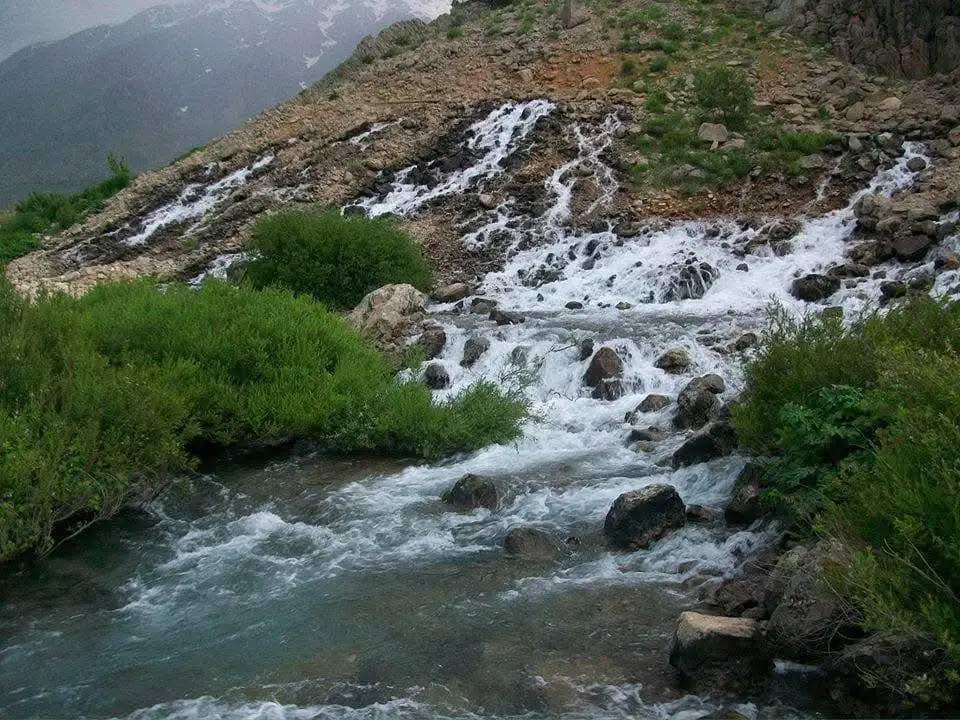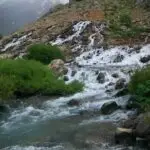Paradise Rivers & Munzur River in Dersim
Paradise and Paradise Rivers
The three Abrahamic religions developed different interpretations of paradise, the place of longing in all three religions, at different times. The Hebrew Bible refers to the earthly paradise as the “Garden of Eden” (Hebrew: גַּן־עֵדֶן gan-ʿĒḏen), which, according to the biblical account of creation in Genesis 2–3 EU [Einheitsübersetzung – standard translation], God created for humans but from which he expelled them after the Fall.
“The name Eden (…) goes back to the Hebrew noun of the same name and means ‘delight’ or ‘land of delight’ [also: ‘land of abundance’].” [1] In Gen 2:8 EU, Eden initially refers to a mythical land that is distinct from the garden that God planted in it. This differing usage is also reflected in the ancient Greek Septuagint, which transcribes the name of the land as Εδεμ Edem, while translating the garden as παράδεισος (parádeisos, from Old Persian pairidaêza ‘enclosure’ [2]).
The differences can be explained by their historical origins: While the older tradition distinguishes between the land of Eden and the garden, the name of the land was transferred to the garden in the literary version of Gen 2f. The reference in Gen 2:10 ELB [Elberfelder Bible] to the river that flows from Eden (…) probably belongs to a later revision that deliberately leaves the relationship between Eden and the garden open. [3]
In Isaiah 51:3 EU, “Eden” is equated with “the garden of the Lord.” Eden is also mentioned repeatedly in the Book of Ezekiel, including with the explanation “garden of God” (Ezekiel 28:13 EU and more often) and with the mention of the “trees of Eden” (Ezekiel 31:9 EU and more often). [4]
For Christians, paradise is a mythical symbol. It describes innocence as the original state before sin – in the form of a thirst for knowledge! – took hold of mankind. Paradise is also a place of yearning and the vision of a world without egocentricity or war.
According to the Christian interpretation of the second and third chapters of Genesis, the Garden of Eden represents paradise. At its center are the tree of life and the tree of the knowledge of good and evil (Genesis 2:9).
God forbids humans to eat the fruit of these two trees. But Adam and Eve disobey him and taste the fruit of the tree of knowledge (Genesis 3:6–7). Because this makes them resemble God, God expels them from paradise and denies them access to the tree of life (Genesis 3:22–24), thereby rendering humans mortal.
Paradise also appears outside the Old Testament (Ta’anakh) in some texts of the Jewish tradition, which expected that paradise would eventually be open to humans again. This idea was taken up in the New Testament in the Book of Revelation (Revelation 2:7; Revelation 22:2; Revelation 22:14; Revelation 22:19).
According to Jewish understanding, paradise was also the place where the pious went after death. This meaning underlies, for example, the promise Jesus made to the criminal who was crucified with him: “Truly, I say to you, today you will be with me in paradise!” (Luke 23:43).
This is how the idea came into Christianity: As soon as Christ returns and the Kingdom of God is complete, the dead will rise and the redeemed will enter paradise. In the Middle Ages, however, the doctrine of paradise was supplemented by the doctrine of purgatory, in which all sins are atoned for before one is purified and enters paradise. The Protestant reformers rejected this idea as not based on the Bible. [5]
In Islam, paradise has been a place in the afterlife and beyond this world from the beginning. According to the Quran, God allows Adam and Eve to live in Janna(h) (Sura 7:19). The Arabic term Jannah (Arabic جنّة, DMG ǧanna) is related to the Hebrew term Gan Eden (גן עדן). عدن, DMG ʿadn ‘Eden’ is also used in the Koran, e.g. in Sura 20:76. Arabic antonyms for Jannah are Jahannam (hell) and Nār (hellfire). Depending on Islamic tradition, Jannah is divided into seven [6] or eight [7] levels (gates), with the highest levels reserved for the most pious. [8]
In numerous passages in the Quran, Jannah is described as a place of joy in the hereafter that is promised to the chosen ones:
“The paradise promised to the righteous is like this: In its lowlands (literally: beneath it) flow rivers. And it has everlasting fruits and shade. That is the final destination of those who are righteous. But the final destination of the unbelievers is the fire of hell.” – Quran: 13:35
“The paradise promised to the God-fearing is like this: In it are streams of water that is not foul, others of milk that tastes (still) unaltered (fresh), others of wine that is a delight to drink, and (still) others of purified honey. They (i.e., the God-fearing) have therein all kinds of fruit and mercy from their Lord (to look forward to). (Are the inhabitants of such a glorious paradise) equal to people who dwell (eternally) in hellfire and are given hot water to drink that tears their intestines apart?” – Quran: 47:15
In medieval Islamic theology, there was often debate as to whether Adam’s paradise was identical to the paradise into which the blessed will enter at the end of time. While al-Hasan al-Basrī and, with him, the founders of the Muʿtazila, Wāsil ibn ʿAtā’ (died 748) and ʿAmr ibn ʿUbaid, taught that they were identical and that the paradise promised to humans had therefore existed from the beginning, Dirār ibn ʿAmr (died 796) believed that paradise and hell would only be created during the Last Judgment. Dirār’s position was later adopted by many other Muʿtazilites such as Hishām al-Fuwatī, ʿAbbād ibn Sulaimān, and Abū Hāshim. The opposing view only prevailed after a long struggle. [9]
Paradise is located above the earth and hell. Unlike in Christian belief, however, God (Allah) does not reside in either of these categories, but is merely considered their creator. Prophets and angels can move between the earthly and heavenly worlds and act as intermediaries. [10] According to the Raa Haqi (Raa Heqi) faith, both hell and paradise exist on this earth, not beyond.
Rivers of Paradise
In Genesis 2:11–15, it is written: “A river flows out of Eden to water the garden, and from there it divides into four main streams. The name of the first is Pishon, which encircles the whole land of Khavila, where there is gold. The gold of this land is good. There you can find the Bedolakh ore [precious resin] and the Shoham stone [carnelian]. The name of the second river is Gikhon, which surrounds the whole land of Kush. The name of the third river is (K)Hid[d]ekel, which flows on the morning side [east] of Ashur, and the fourth river is Perat.”
There are widely differing interpretations as to who these four rivers of paradise are. Whether geographical identification is possible at all depends in turn on whether the Garden of Eden is located on earth or in the beyond.
The Perat is usually identified as the Euphrates (Greek), Furat (Kurdish/Arabic), Frat (Armenian), Fırat (Turkish), Pu-rat-tu (Old Assyrian) and Ufrat. The Old Persian version Ufrat, from which most other toponyms are derived, comes from the compound term Huperethuua, which means “easy to cross” (“Hu” – “good”; ‘Peretu’ – “ford”). Among Armenians, the popular belief that the Euphrates was sacred remained alive until the end of the 19th century. There was also a belief that whoever crossed the Euphrates and drank its water would gain the gift of healing wounds. [11]
The (K)Hid(d)ekel is usually equated with the Tigris; however, the etymology is unclear. In the languages of the region, the river has the following names: Sumerian idigna, Akkadian idiglat, Aramaic: deqlath, didshla, Old Persian: tigrā, Arabic دجلة didshla, DMG diǧla, Hebrew: חידקל, ḥiddæqæl or, simplified, chiddekel, Armenian Տիգրիս Tigris, Turkish Dicle and in Kurdish Dîcle. In many countries in the Middle East, the name Ditjle is used. The names Tigris or Tikrit are also common.
In Sumerian, id means “river,” so the name can be broken down into id-igna. Since there is a Sumerian word with a similar sound, igira, meaning “heron,” and the cuneiform character for idigna in its oldest form could be interpreted as a picture of a heron, Jan Keetman suggests that the name could be translated as “heron river.” [12]
In Old Persian, according to Rüder Schmitt, the river name was borrowed from Babylonian and interpreted as “arrow-fast” because of its rapid current. [13]
The Bible gives no indication as to which river the Gihon is. The Kush associated with it in the Bible later mostly referred to Ethiopia. This is probably where the identification with the Nile comes from. Originally, a different place was meant.
Possible candidates are the Sumerian-Akkadian city-state of Kiš in Mesopotamia, which is mentioned in records dating from around 2800 BC, or the Hittite city of Kush(ar) or Kuššara, which has not yet been located.
Egyptologist David Rohl believes that the Aras is the biblical Gihon. Rohl cites a document from the time of the Islamic invasion of Persia that proves the Aras was known under the name Gyhun until the 7th century. The old name of the region on the Gyhun was Kush. One of the peaks in the region is still called Kusha-Dagh (“Mountain of Kush”) today.
The Aras, Araks or Arax (Azerbaijani: Araz, Persian: ارس Aras, Armenian: Արաքս Araks, Kurdish: Erez, Urartian: Muna, Greek: Araxes, Turkish: Aras Nehri) is the longest tributary of the Kura in the Near East, with a length of 1072 km. [14]
Another interpretation identifies the paradise river Gihon with the Ceyhun (Turkish) or Amudarya (Persian: Oxos).
In medieval texts, this river is called Dschayhun (جيحون, DMG Ǧayḥūn) in both Arabic and Persian. In Iranian mythology, it is a contested border river between Iran and Turan. The name Āmūdaryā (آمودریا), which is also common in modern Persian usage, is a compound of the words āmū(y) (آمو), the name of a sandy plain in Transoxania, and daryā (New Persian دريا, ‘sea’), which derives via Middle Persian drayak from the Old Persian drayah (meaning ‘sea’ or ‘large watercourse’). In other languages, the name is accordingly: Uzbek Amudaryo; Tajik Омударё Omudarjo, Turkmen Amyderýa, Karakalpak Ámiwdárya, Russian Амударья Amudarja.
The river Pishon is connected to the land of Khawila. The German theologian and classical philologist (Ugarith) Manfried Dietrich identifies the Pishon with the Karun in southwestern Iran, David Rohl with the Ghezel Ozan, a tributary of the Iranian Sefid Rud. At 720 km, the Karun is the longest and only navigable river in Iran. In the Sumerian Epic of Gilgamesh, it is often referred to as the “Ulai River.”
Of the four possible rivers of paradise, three originate in the historical Armenian Highland: the Euphrates and Tigris near the present-day city of Elazığ, and the Arax south of Erzurum in the Bingöl Mountains. From its source, it flows eastward, passing Mount Ararat to the north. In this area, the river also forms the border with Armenia. Later, it becomes the border river between Iran and the Azerbaijani exclave of Nakhchivan, and continues to form the border between Iran and Armenia and Azerbaijan. In Azerbaijan, it flows through the Mugan steppe and empties into the lower reaches of the Kura, which flows into the Caspian Sea.
Two other rivers in the source region of the Euphrates and Tigris, which are or were tributaries of one or both of these rivers, can also be considered part of the network of sacred paradise rivers, including the Murat, the longest source river of the Euphrates. The Murat River, also called Eastern Euphrates (Turkish: Murat Nehri, Kurdish: Çemê Miradê, Armenian: Արածանի – Aratsani), is a major source of the Euphrates River. The Ancient Greeks and Romans used to call the river Arsanias (Ancient Greek: Ἀρσανίας). It originates near Mount Ararat north of Lake Van, and flows westward for 722 km through mountainous terrain.
The river was called Arșania in sources of the Neo-Assyrian Empire, and Arsanias in Classical Greek and Roman sources. Those forms may be derived from an earlier form of Armenian Արածանի Aratsani, which Armen Petrosyan derives from an Armenian descendant of the Proto-Indo-European root *h₂erǵ ‘white, bright’. [15] Armenian Aratsani may have developed from an earlier form *Artsani (whence Akkadian Arșania with the addition of the toponymic suffix -iya and Greek Arsanias) under the influence of many other Armenian toponyms beginning with Ara-.
The present name is usually connected with the Turkish given name Murat or the word from which that name derives, murat ‘purpose, intention, desire’. But this may be folk etymology, so the US-Armenian linguist Hrach Martirosyan tentatively proposes derivation from Old Armenian mōrat, murat ‘mud, marsh’. [16]
In an interview, the co-founder of the newspaper ‘Agos’, Sarkis Seropyan (1935-2015), spoke about the veneration of Aratsan (Western Armenian: Aradzan) and the paradise river Euphrates in Dersim, dating back well before Abrahamic religions: “The Armenians in Dersim regard the Euphrates as a mother with arms. They also see Mount Munzur as a mother figure. They even compare its silhouette to the goddess Anahit. Traditions tell that the milk that flowed from the breasts of this goddess gave rise to the rivers Euphrates and Munzur.
I think rivers play a central role in Armenian religious culture. Two rivers are central to this: the Euphrates and the Murat (which we call Aradsan). The Aradsan is a particularly sacred river for Armenians, as it was there that the first Christian baptisms took place.” [17]
Munzur – Dersim’s Sanctified River
In Dersim’s worship of the elements, water, which many cultures associate with fertility and femininity, played a special role. In Mazdaism, water is seen as the source of life and a purifying element that symbolizes both physical and spiritual purification. The Indo-Iranian goddess of fertility, medicine and wisdom, Ardvisura Anahita, is closely associated with water and is revered as the source of all waters. She is an important figure in ancient Iranian and Armenian mythology and plays a role in the preservation of the world.
From the account of the journey of the Armenian-Arshakid king Trdat I (63-80) to Rome, as recorded by Pliny in Hist. Nat. XXX.2, we learn that the sea was also considered sacred in the Mazdaist faith and that sea voyages were therefore forbidden because they would inevitably have polluted the sea. King Trdat was a magician-priest and as such bound by certain rites and regulations that forbade him, for example, from sailing the sea. He therefore undertook the long and arduous journey to Rome by land. [18]
The Raa Haqi religion of Dersim has a tradition dating back over three thousand years of ancient Iranian elemental and water worship. Springs play the most important role in the latter. They are believed to have supernatural powers and to bestow miraculous powers on those who bathe in them or drink their water. In the Raa Haqi religion, the Munzur, which rises from the sacred mountain of the same name and flows through Dersim from west to east, is a sacred, living being, to whose source tens of thousands of people make a pilgrimage every year: there they say prayers, light →Çıras and offer →Niyaz. [19]
The Ana Fatma shrine on the road between Dersim and Ovacık is another natural sanctuary and is considered one of the most important places of worship and pilgrimage for the people of Dersim, especially for women. In her role as guardian of water and fertility, the Indo-Iranian goddess Anahit(a) lives on there in the shape of Ana Fatma (Fatima), the daughter of the Prophet Muhammad—even in her name. Visitors to Ana Fatma also light candles and say prayers at this natural sanctuary. After the prayers, small snacks and sweets are distributed to the visitors.
“This close relationship with water does not come from books or institutions, but is passed down through dreams, stories, and rituals. The land remembers through water. And when Alevis go to a holy spring, kneel on the riverbank, or light a candle beside a lake, they are not just carrying out a tradition—they are encountering a living being that sees, hears, and responds.” [20]
Conclusion
In conclusion, the idea of paradise and its rivers—rooted in ancient texts and theological imaginaries—is reinterpreted in uniquely grounded ways within Alevism, particularly in the Raa Haqi tradition of Dersim. Unlike the transcendental or otherworldly paradises envisioned in dominant Abrahamic narratives, Alevism locates paradise in this world, in nature itself, and most powerfully in sacred geographies like the Munzur River. As a living waterway, Munzur is not only revered as a site of ritual and pilgrimage but also experienced as a spiritual presence—one that nurtures, observes, and remembers. In Alevi cosmology, it embodies both the metaphysical flow of divine essence and the material memory of suffering, resilience, and ecological sanctity. It offers a model of paradise that is immanent, relational, and moral—where water does not merely cleanse, but also testifies, heals, and binds communities together. The Munzur River thus stands at the heart of a distinct Alevi understanding of the sacred: a paradise not beyond death, but within life, inscribed in the landscape, and carried in the collective breath of a people.
- Gesenius, Wilhelm: Hebräisches und aramäisches Handwörterbuch über das Alte Testament. 18. Auflage. Berlin/Heidelberg: Springer-Verlag, 2013, p. 927. ↩
- Bauer, Walter: Griechisch-deutsches Wörterbuch zu den Schriften des Neuen Testaments und der frühchristlichen Literatur. 6. Auflage. Berlin/New York: Walter de Gruyter & Co. 1988, p. 1242. ↩
- Henrik Pfeiffer: Eden. In: Bauks, Michaela; Koenen, Klaus; Alkier, Stefan (Hrsg.): Das wissenschaftliche Bibellexikon im Internet (WiBiLex), Stuttgart, 2006 ff. ↩
- Ibid. ↩
- Evangelische Kirche in Deutschland: Paradies – Basiswissen Glauben. https://www.ekd.de/Paradies-Basiswissen-Glauben-11240.htm ↩
- Werner, Helmut (Hrsg.): Das islamische Totenbuch – Jenseitsvorstellungen des Islam, nach der Dresdner und Leipziger Handschrift, neu herausgegeben. Köln 2009, p. 191 ff. ↩
- Hughes, Thomas Patrick: Lexikon des Islam, Wiesbaden 1995, p. 574 ↩
- Spuler-Stegemann, Ursula: Die 101 wichtigsten Fragen, Islam. München, C. H. Beck 2007, p. 43 ↩
- Ess, Josef van: Theologie und Gesellschaft im 2. und 3. Jahrhundert der Hidschra. Eine Geschichte des religiösen Denkens im frühen Islam. Berlin: De Gruyter, 1991–1997, Bd. 3, p. 53 f. ↩
- Ibid. ↩
- Ishkol-Kerovpian, K.: Mythologie der vorchristlichen Armenier. In: Wörterbuch der Mythologe. Hrsg. von W.W. Hauser. I. Abteilung: Die alten Kulturvölker. Bd. IX, 1. Teil: Kaukasische Völker. 11.Lieferung. Stuttgart. Ernst Klett Verlag, p. 157 ↩
- Keetman, J.: Zur Schreibung des Wortes idigna „Tigris“ und der möglichen Bedeutung „Reiherfluss“. In: Bibliotheca Orientalis, Band 73, 2016, p. 7–11 ↩
- Schmitt, Rüder: Wörterbuch der altpersischen Königsinschriften. Reichert, Wiesbaden 2014, p. 255 ↩
- https://de.wikipedia.org/wiki/Aras_(Fluss) ↩
- Petrosyan, Armen: The Indo-European and Ancient Near Eastern Sources of the Armenian Epic. Washington, D.C: Institute for the Study of Man. 2002, pp. 73–74, 186 ↩
- Martirosyan, Hrach: “Armenian mawr ‘mud, marsh’ and its hydronymical value”. Aramazd: Armenian Journal of Near Eastern Studies, 2009, 4 (1), pp. 80–81 ↩
- :Gündoğan, Kazım: Alevileş(tiril)miş Ermeniler; Dersimli Ermeniler-2: “Biz İsa’ya Tabiyiz, Ali’ye Mecburuz”. Istanbul: Ayıntı Yayınları 2023, p. 475 ↩
- Ishkol-Kerovpian, a.a.O., p. 135 ↩
- Die Geburt des Munzur – Heiliger Fluss, umkämpfte Landschaft. „Deutsche Digitale Bibliothek: Ausstellungen“, https://ausstellungen.deutsche-digitale-bibliothek.de/heilige-geografie-dersim-und-diaspora/items/show/25 ↩
- Heilige Landschaften der Alevis von Dersim. „Deutsche Digitale Bibliothek: Ausstellungen“, https://ausstellungen.deutsche-digitale-bibliothek.de/heilige-geografie-dersim-und-diaspora/#s18 ↩
Bauer, Walter. 1988. Griechisch-deutsches Wörterbuch zu den Schriften des Neuen Testaments und der frühchristlichen Literatur. 6th ed. Berlin and New York: Walter de Gruyter & Co.
Evangelische Kirche in Deutschland. n.d. “Paradies – Basiswissen Glauben.” https://www.ekd.de/Paradies-Basiswissen-Glauben-11240.htm.
Gesenius, Wilhelm. 2013. Hebräisches und aramäisches Handwörterbuch über das Alte Testament. 18th ed. Berlin and Heidelberg: Springer-Verlag.
Gündoğan, Kazım. 2023. Alevileş(tiril)miş Ermeniler; Dersimli Ermeniler-2: “Biz İsa’ya Tabiyiz, Ali’ye Mecburuz”. Istanbul: Ayıntı Yayınları.
Hughes, Thomas Patrick. 1995. Lexikon des Islam. Wiesbaden.
Ishkol-Kerovpian, K. n.d. “Mythologie der vorchristlichen Armenier.” In Wörterbuch der Mythologie, edited by W. W. Hauser, vol. IX, part 1, 11th fasc., 157. Stuttgart: Ernst Klett Verlag.
Keetman, J. 2016. “Zur Schreibung des Wortes idigna ‚Tigris‘ und der möglichen Bedeutung ‚Reiherfluss‘.” Bibliotheca Orientalis 73: 7–11.
Martirosyan, Hrach. 2009. “Armenian mawr ‘mud, marsh’ and Its Hydronymical Value.” Aramazd: Armenian Journal of Near Eastern Studies 4 (1): 80–81.
Pfeiffer, Henrik. 2006ff. “Eden.” In Das wissenschaftliche Bibellexikon im Internet (WiBiLex), edited by Michaela Bauks, Klaus Koenen, and Stefan Alkier. Stuttgart.
Petrosyan, Armen. 2002. The Indo-European and Ancient Near Eastern Sources of the Armenian Epic. Washington, D.C.: Institute for the Study of Man.
Schmitt, Rüder. 2014. Wörterbuch der altpersischen Königsinschriften. Wiesbaden: Reichert.
Spuler-Stegemann, Ursula. 2007. Die 101 wichtigsten Fragen, Islam. Munich: C. H. Beck.
van Ess, Josef. 1991–1997. Theologie und Gesellschaft im 2. und 3. Jahrhundert der Hidschra. Eine Geschichte des religiösen Denkens im frühen Islam. Vol. 3. Berlin: De Gruyter.
Werner, Helmut, ed. 2009. Das islamische Totenbuch – Jenseitsvorstellungen des Islam, nach der Dresdner und Leipziger Handschrift, neu herausgegeben. Cologne.
Wikipedia contributors. n.d. “Aras (Fluss).” Wikipedia. https://de.wikipedia.org/wiki/Aras_(Fluss).
Online Exhibitions
Deutsche Digitale Bibliothek. n.d. Die Geburt des Munzur – Heiliger Fluss, umkämpfte Landschaft. (Curator: Dr. Ahmet Kerim Gültekin) https://ausstellungen.deutsche-digitale-bibliothek.de/heilige-geografie-dersim-und-diaspora/items/show/25.
———. n.d. Heilige Landschaften der Alevis von Dersim. https://ausstellungen.deutsche-digitale-bibliothek.de/heilige-geografie-dersim-und-diaspora/#s18.




